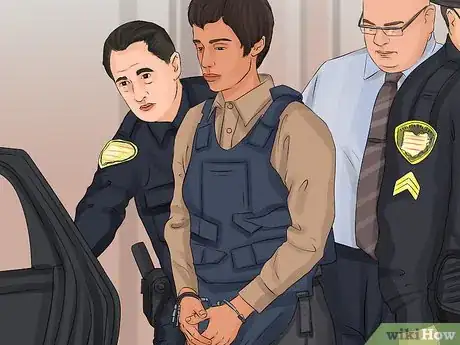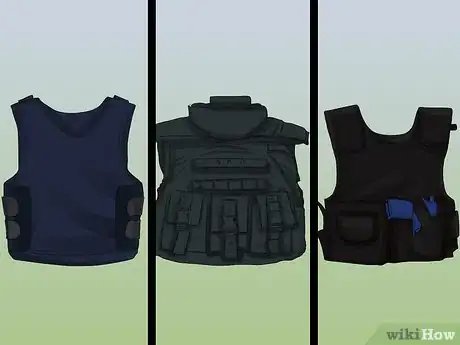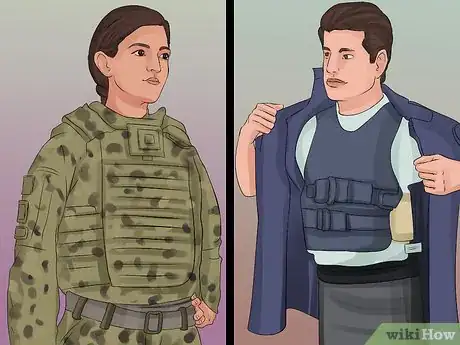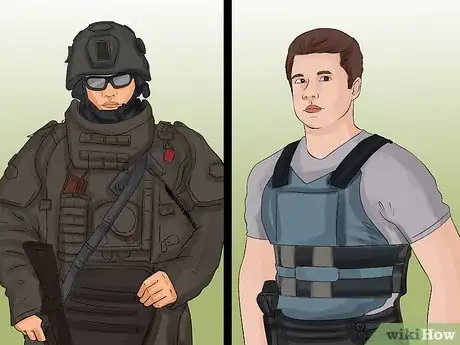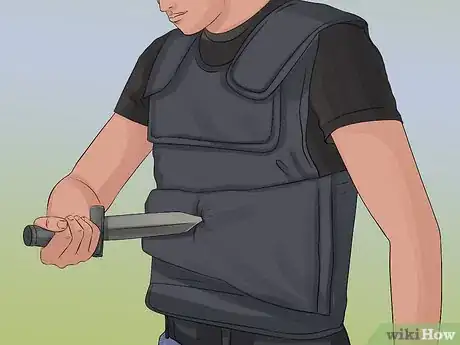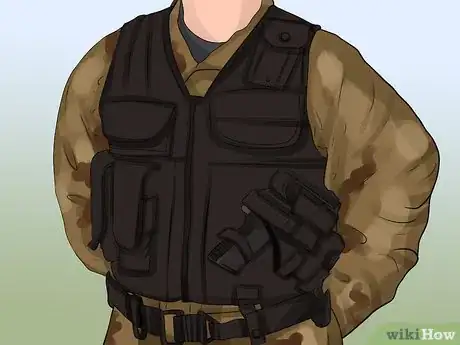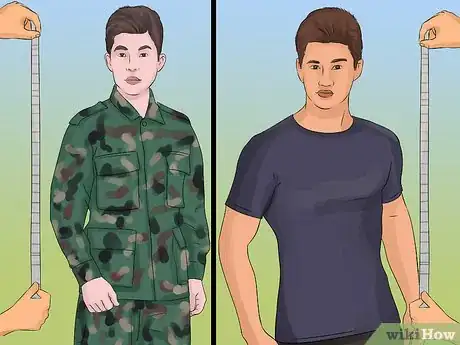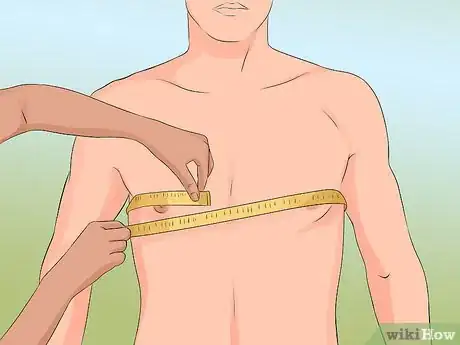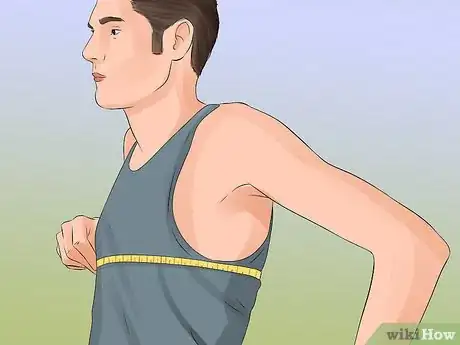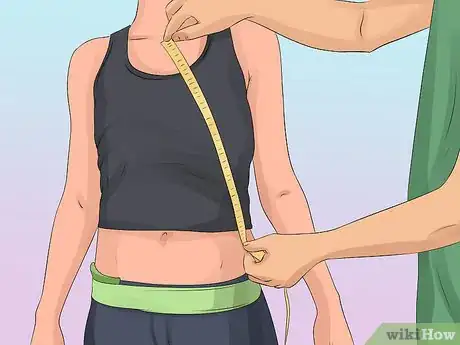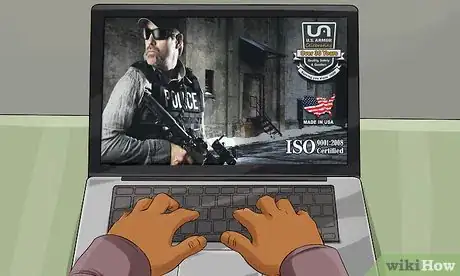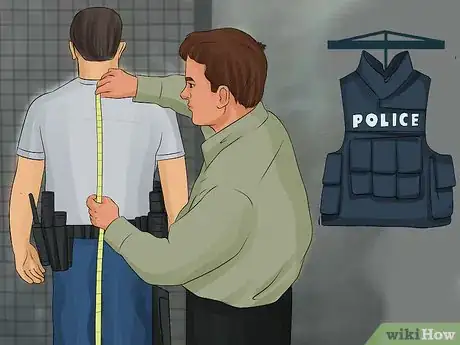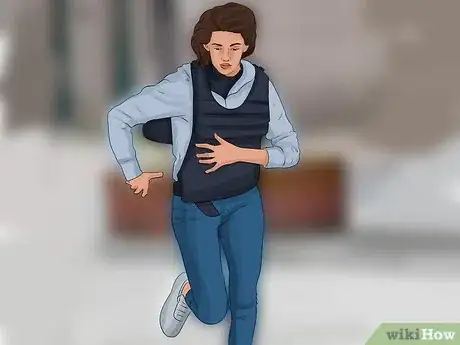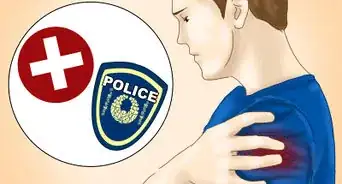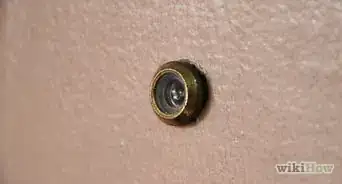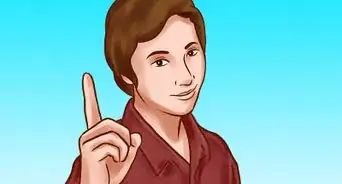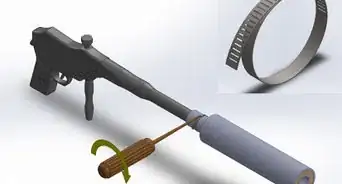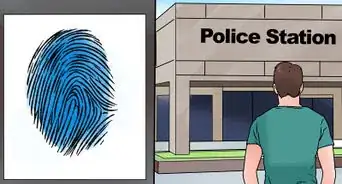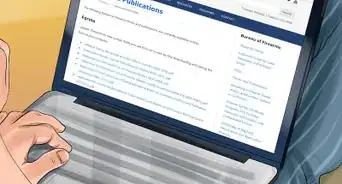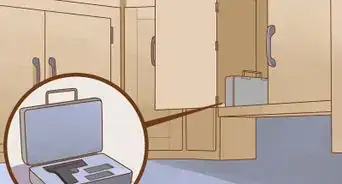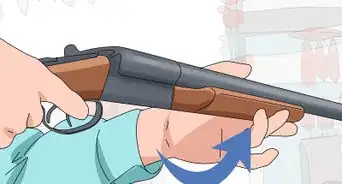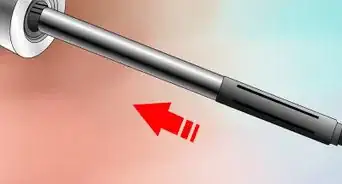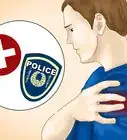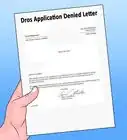This article was co-authored by wikiHow Staff. Our trained team of editors and researchers validate articles for accuracy and comprehensiveness. wikiHow's Content Management Team carefully monitors the work from our editorial staff to ensure that each article is backed by trusted research and meets our high quality standards.
There are 12 references cited in this article, which can be found at the bottom of the page.
wikiHow marks an article as reader-approved once it receives enough positive feedback. This article received 12 testimonials and 91% of readers who voted found it helpful, earning it our reader-approved status.
This article has been viewed 326,953 times.
Learn more...
If you find yourself in a situation where people are shooting at you, a bulletproof vest may be the piece of equipment that saves your life. Bulletproof vests are typically made of a strong woven fiber called Kevlar or contain a ballistics plate that is capable of stopping bullets before they penetrate your body. When buying a bulletproof vest, it's important to weigh all of your options and make sure it fits before making your final decision. If you educate yourself on different models and measure yourself correctly, you can get a bulletproof vest that fits comfortably and protects you from gunfire.
Steps
Weighing Your Options
-
1Determine if it’s legal for you to buy and wear a vest. If you’ve ever been convicted of a violent crime, it’s illegal to wear body armor in the United States. In certain places, like Australia, it’s illegal to wear a bulletproof vest without a permit. Search online for your local and federal laws related to bullet proof vests or body armor, and make sure that you don’t need a permit to purchase one.[1]
- If you do need a permit, follow your state or country’s application process and get a permit before attempting to purchase a vest
-
2Choose a vest based on the threat that you’re likely to encounter. Lighter, thinner ballistics vests like the IIA, II, and IIIA are made to stop bullets from handguns. These three vests are recommended if you are likely to encounter small arms fire. If you are in a more dangerous war zone, however, you’ll need the protection of a level III vest, which can stop rifle bullets. Determine what kind of atmosphere you’re in and the potential threats around you.[2]
- If you're a civilian that’s not in a war zone, get a lighter vest so that you can wear it under your clothes.
- The IIA can stop bullets from a 9mm or .40 caliber handgun.
- The II vest can stop 9mm and .357 caliber handgun bullets.
- An IIIA vest can stop larger caliber handgun bullets like a .357 SIG and .44 Magnum.
- For the greatest protection, purchase a level IV vest which can save you from .30 caliber armor piercing rounds.
Advertisement -
3Decide if you want a concealed or an external vest. If you’re a civilian or an undercover agent, you’ll want to wear a vest that won’t be seen. External vests and plates fit over your existing clothing and are usually preferred by military personnel or police officers because they are easier to remove.[3]
-
4Consider your needed level of mobility. The higher the protection level on your vest, the thicker and heavier it becomes. If you need to be agile and quick on your feet, consider getting a lighter vest like the II or IIA. Heavier body armor may feel clunky and will be harder to move in.[4]
-
5Consider purchasing stab resistant armor to stop blade attacks. Look at the armor panel label on the inside of your vest to determine whether it’s made to protect you from knife attacks.[5] If you think you’ll be in a situation where your greatest threat is a blade, consider purchasing a stab-resistant vest rather than a standard ballistics vest. Combination armor is also an option, as it's specially designed to stop both bullets and knives.[6]
- If you’re a correctional officer, there’s a greater chance of you being slashed or stabbed than getting shot.
-
6Get a vest that can stop a bullet from the gun that you plan on carrying. If you intend on carrying a gun, you should at very least purchase a vest that’s capable of stopping a bullet from the weapon that you plan on carrying. This may save your life if you’re disarmed and your own weapon is used against you.[7]
Taking Your Measurements
-
1Measure your height and weight. Most vests will have sizes based on your height and weight. Use a tape measure to determine how tall you are. Step on a scale and to get your current weight and write the measurements on a piece of paper.
-
2Wear the clothes you’ll be wearing while measuring yourself. If you are buying a concealed vest, wear a tight fitting t-shirt and pants. If you are wearing a larger, exterior vest, wear the uniform or clothes you’ll be wearing and then measure yourself. This will give you a more accurate idea of what vest size you need while you’re out in the field.
- If you're a law enforcement official, remember to wear your utility belt and the gear you’d normally be carrying.
-
3Measure your chest. Have someone help when taking measurements. Wrap a tape measure around your chest so that the tape runs under your armpits and across your back. Take the measurement and round it up to the next whole number. Make a note of measurement.
- For instance if your chest measurement was 16.25 inches (41.3 cm), you’ll want to round up to 17 inches (43 cm).
- Relax your muscles and breathe normally while you get measured for your vest.
-
4Measure around the largest part of your torso. Wrap the tape measure around the widest part of your torso. Round this number up as well.[8]
-
5Measure from your collarbone to your navel. Hold the tape measure up to the center of your collarbone and let the tape hang under your navel. If you're wearing a utility belt, measure from the center of your collarbone to the top of the belt. Use this measurement to determine how long your vest should be.[9]
- Some people make the mistake of getting a vest that hangs down below their hips for extra protection. This is actually bad because it hinders mobility while you wear it.
Purchasing the Right Vest
-
1Make sure that the vest you want to buy is on the NIJ compliant list. The National Institute of Justice, or NIJ, has created a list of tested manufacturers. This organization tests the vests and then grades them depending on their level of protection. Instead of risking it and getting a vest that isn’t certified, choose a manufacturer that has already been tested. To get a list of all the certified manufacturers, visit https://justnet.org/compliant/ballistic_cpl.html.[10]
- Look online for reviews of different manufacturers to help you make your decision.
- If you like a certain manufacturer for the other equipment they produce, there’s a good chance you’ll like the vests that they manufacture.
-
2Go to the manufacturer's website. The link to the manufacturer's website can be found directly on the NIJ compliant list. Some companies will allow direct sales while others will require you to go to a physical location. Find a button that says “find retailers” or look on their contact page for their location. Once you find the location, you can visit and authorized dealer and purchase the vest.[11]
-
3Compare your body measurements with the vest measurements. As you look for vests to purchase, compare your body measurements with the vest that you want to buy. If the manufacturer doesn’t list the dimensions of the vest, you can request it through email or by giving them a call. They may want you to come into the store so that they can measure you.
-
4Purchase a vest that fits within your budget. Determine how much money you have to spend on the vest and get one that falls within your budget. Some vests cost extra because of their style or look. Others will cost more because of their level of protection or innovative extra features.
- Regardless of the cost, make sure that the vest is approved by the National Institute of Justice.
-
5Try the vest on before you buy it. Make sure that you feel comfortable in the vest and that it isn’t too tight or too loose on your body. If it feels too bulky and you can’t move your arms, find a vest that fits you better.[12]
- You should never wear another person's vest because it won’t fit correctly and won’t fully protect you.
- If you're buying your vest online, make sure that they have a return or replacement policy so that you can send it back if it doesn't fit.
-
6Move around while wearing the vest. Run around and sit in a chair while wearing the vest. Your vest should feel comfortable whether you're running or sitting. Try to do different physical acts and see if your vest interferes with your ability to move. The vest should not shift too high or low as you’re making your movements.[13]
-
7Get a replacement vest every five years or after it gets hit with a bullet. Once the vest gets shot, the bullet can crack the ballistics plate and damage the material, so it must be replaced. It's also recommended that you replace your bulletproof vest every five years. After a couple of years, the material inside of the vest starts to break down. While an expired vest may still stop a bullet, it's better to be safe than sorry.[14]
Community Q&A
-
QuestionCan a civilian purchase a bullet proof vest?
 Community AnswerIf you haven't committed a crime, then generally yes. However, check your state's laws on such matters, as some retailers only sell to policemen or SWAT.
Community AnswerIf you haven't committed a crime, then generally yes. However, check your state's laws on such matters, as some retailers only sell to policemen or SWAT. -
QuestionCan a normal bulletproof vest stop a bullet from a sniper's rifle?
 Community AnswerA normal bulletproof vest can stop whatever it is rated for, but there are larger vests like plates that can stop larger rifle calibers.
Community AnswerA normal bulletproof vest can stop whatever it is rated for, but there are larger vests like plates that can stop larger rifle calibers. -
QuestionWhat's the difference between body armor and a plate carrier?
 Community AnswerA "plate carrier" holds the ballistic armour plate as part of a body armour system. Without the plate the carrier is just an empty Cordura bag. Armoured Plates can be rated as "stand alone" ballistic protection for different types of munitions or used as an external layering system with a soft kevlar vest backing to the plate for added protection.
Community AnswerA "plate carrier" holds the ballistic armour plate as part of a body armour system. Without the plate the carrier is just an empty Cordura bag. Armoured Plates can be rated as "stand alone" ballistic protection for different types of munitions or used as an external layering system with a soft kevlar vest backing to the plate for added protection.
References
- ↑ http://www.aele.org/law/2010all05/2010-05MLJ201.pdf
- ↑ https://justnet.org/pdf/Understanding-Armor-Protection.pdf
- ↑ https://www.justnet.org/blog-6-16-16.html
- ↑ https://journals.sagepub.com/doi/abs/10.1177/0887302X11420479
- ↑ https://www.justnet.org/body_armor/body_armor_labels.html
- ↑ https://www.policearmor.org/basics/body-armor.html
- ↑ https://www.policearmor.org/faqs.html
- ↑ https://www.youtube.com/watch?v=7pLrdGqnZig&feature=youtu.be&t=1m30s
- ↑ https://www.youtube.com/watch?v=7pLrdGqnZig&feature=youtu.be&t=2m
